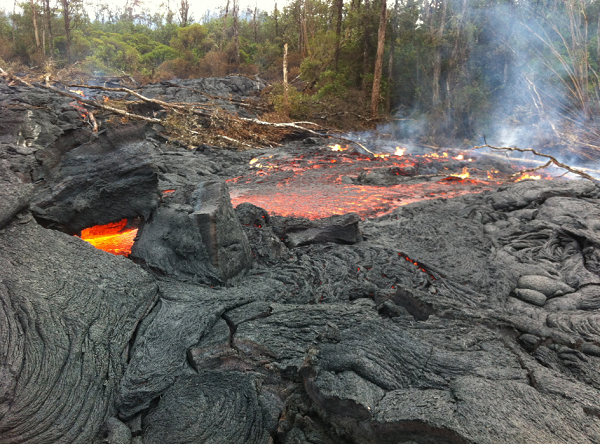Kilauea Volcano Photos: Hawaii Lava Flow Poses A Threat To People And Wildlife In Nearby Areas

Lava spewing into the ocean from Hawaii’s seaside Kamokuna cliff isn’t thrusting out as intensely as the firehose-like flow of lava that was first seen sprouting out of the lava delta back on New Year’s Eve. However, bits of molten lava and black sand spotted flying through the steam plume on the volcano’s south coast Thursday confirmed that Hawaii’s Kilauea volcano is still very active, according to the Hawaiian Volcano Observatory.
A stream of lava pouring from Hawaii's Kilauea volcano causes explosions when it hits the Pacific Ocean. pic.twitter.com/0o69ELDBKx
— CNN Travel (@CNNTravel) February 2, 2017
Kilauea first erupted 34 years ago and has continued to remain active in the eastern rift zone of Pu’u ‘O’o into the Kamokuna ocean cliff entry. The volcano’s New Year’s Eve eruption, which was caused when 21 acres of lava delta to collapsed into the ocean, has outlasted most cases of lava streams that occasionally sprout out of Kamokuna. In most cases, lava streams only last one to two days.
Officials are concerned that the ongoing lava stream at Kamokuna will lead to further collapses of the sea cliff, which could pose an extreme threat to people and wildlife on nearby land as well as boats who use the ocean entry near Kamokuna’s site. The only way to end the ongoing flow of lava is if the actual volcano stops erupting or if a large earthquake can prevent the lava from flowing.
Lava Pours Steadily From Hawaii's Kilauea Volcano https://t.co/2LSWyHyiHm pic.twitter.com/SakhtGeUTx
— Terez Owens (@TerezOwens) February 3, 2017
“The only thing we can surmise is the offshore topography apparently is so steep that, as the lava is flowing in and forming all this new rubble, it’s just slipping down into deeper parts of the ocean and not piling up to form a new delta,” Janet Babb, a geologist at the United States Geological Survey Hawaiian Volcano Observatory, told the New York Times Wednesday. “Lava will continue to flow into the ocean until it’s disrupted.
Normally when lava from an eruption hits the salty water, it causes an explosion that sends spatter (bits of molten lava) shooting out of the ocean followed by a steamy cloud of acid. Underneath the ocean’s surface, the lava starts to cool and creates rubble, which usually stacks up resulting in a rocky terrain that the lava settles into, creating a lava deltas such as Kamokuna.
Following the New Year’s Eve collapse, lava tubes were exposed, resulting in more than 100 feet of lava continuing to flow down into the sea.
Boat tourists witness spectacular moment volcano lava spews into sea ... Hawaii is cool. https://t.co/QDxZssChrc pic.twitter.com/ykwcqvUXlW
— Frank Strait (@SCwxFrankStrait) January 24, 2017
“Lava deltas are inherently unstable because they’re built on a foundation of rubble,” Babb said.
Big Island Hawaii Volcano National Park today: a 'faucet' of lava constantly pouring into the ocean. Amazing Hypnotic pic.twitter.com/Zeo16gSruf
— Dr. Laura Duggan (@drlauraduggan) January 25, 2017
The area is a popular tourist attraction as many people have visited the Kamokuna site for glimpses of the lava delta. Park rangers have determined safe viewing areas for visitors to watch the ongoing lava flow.
© Copyright IBTimes 2024. All rights reserved.






















